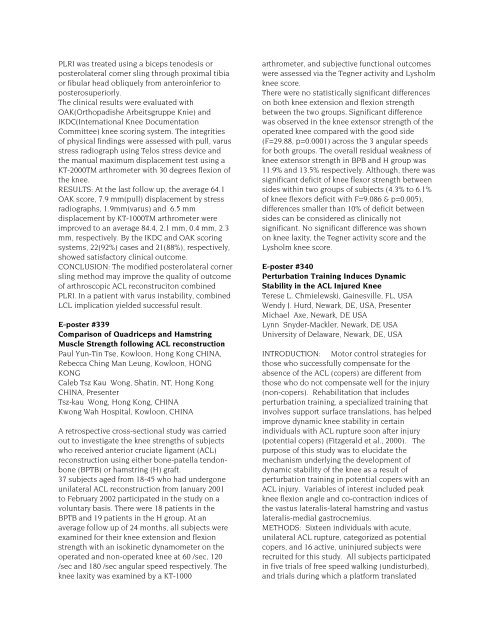POSTER ABSTRACTS - ISAKOS
POSTER ABSTRACTS - ISAKOS
POSTER ABSTRACTS - ISAKOS
You also want an ePaper? Increase the reach of your titles
YUMPU automatically turns print PDFs into web optimized ePapers that Google loves.
PLRI was treated using a biceps tenodesis or<br />
posterolateral corner sling through proximal tibia<br />
or fibular head obliquely from anteroinferior to<br />
posterosuperiorly.<br />
The clinical results were evaluated with<br />
OAK(Orthopadishe Arbeitsgruppe Knie) and<br />
IKDC(International Knee Documentation<br />
Committee) knee scoring system. The integrities<br />
of physical findings were assessed with pull, varus<br />
stress radiograph using Telos stress device and<br />
the manual maximum displacement test using a<br />
KT-2000TM arthrometer with 30 degrees flexion of<br />
the knee.<br />
RESULTS: At the last follow up, the average 64.1<br />
OAK score, 7.9 mm(pull) displacement by stress<br />
radiographs, 1.9mm(varus) and 6.5 mm<br />
displacement by KT-1000TM arthrometer were<br />
improved to an average 84.4, 2.1 mm, 0.4 mm, 2.3<br />
mm, respectively. By the IKDC and OAK scoring<br />
systems, 22(92%) cases and 21(88%), respectively,<br />
showed satisfactory clinical outcome.<br />
CONCLUSION: The modified posterolateral corner<br />
sling method may improve the quality of outcome<br />
of arthroscopic ACL reconstruciton combined<br />
PLRI. In a patient with varus instability, combined<br />
LCL implication yielded successful result.<br />
E-poster #339<br />
Comparison of Quadriceps and Hamstring<br />
Muscle Strength following ACL reconstruction<br />
Paul Yun-Tin Tse, Kowloon, Hong Kong CHINA,<br />
Rebecca Ching Man Leung, Kowloon, HONG<br />
KONG<br />
Caleb Tsz Kau Wong, Shatin, NT, Hong Kong<br />
CHINA, Presenter<br />
Tsz-kau Wong, Hong Kong, CHINA<br />
Kwong Wah Hospital, Kowloon, CHINA<br />
A retrospective cross-sectional study was carried<br />
out to investigate the knee strengths of subjects<br />
who received anterior cruciate ligament (ACL)<br />
reconstruction using either bone-patella tendonbone<br />
(BPTB) or hamstring (H) graft.<br />
37 subjects aged from 18-45 who had undergone<br />
unilateral ACL reconstruction from January 2001<br />
to February 2002 participated in the study on a<br />
voluntary basis. There were 18 patients in the<br />
BPTB and 19 patients in the H group. At an<br />
average follow up of 24 months, all subjects were<br />
examined for their knee extension and flexion<br />
strength with an isokinetic dynamometer on the<br />
operated and non-operated knee at 60 /sec, 120<br />
/sec and 180 /sec angular speed respectively. The<br />
knee laxity was examined by a KT-1000<br />
arthrometer, and subjective functional outcomes<br />
were assessed via the Tegner activity and Lysholm<br />
knee score.<br />
There were no statistically significant differences<br />
on both knee extension and flexion strength<br />
between the two groups. Significant difference<br />
was observed in the knee extensor strength of the<br />
operated knee compared with the good side<br />
(F=29.88, p=0.0001) across the 3 angular speeds<br />
for both groups. The overall residual weakness of<br />
knee extensor strength in BPB and H group was<br />
11.9% and 13.5% respectively. Although, there was<br />
significant deficit of knee flexor strength between<br />
sides within two groups of subjects (4.3% to 6.1%<br />
of knee flexors deficit with F=9.086 & p=0.005),<br />
differences smaller than 10% of deficit between<br />
sides can be considered as clinically not<br />
significant. No significant difference was shown<br />
on knee laxity, the Tegner activity score and the<br />
Lysholm knee score.<br />
E-poster #340<br />
Perturbation Training Induces Dynamic<br />
Stability in the ACL Injured Knee<br />
Terese L. Chmielewski, Gainesville, FL, USA<br />
Wendy J. Hurd, Newark, DE, USA, Presenter<br />
Michael Axe, Newark, DE USA<br />
Lynn Snyder-Mackler, Newark, DE USA<br />
University of Delaware, Newark, DE, USA<br />
INTRODUCTION: Motor control strategies for<br />
those who successfully compensate for the<br />
absence of the ACL (copers) are different from<br />
those who do not compensate well for the injury<br />
(non-copers). Rehabilitation that includes<br />
perturbation training, a specialized training that<br />
involves support surface translations, has helped<br />
improve dynamic knee stability in certain<br />
individuals with ACL rupture soon after injury<br />
(potential copers) (Fitzgerald et al., 2000). The<br />
purpose of this study was to elucidate the<br />
mechanism underlying the development of<br />
dynamic stability of the knee as a result of<br />
perturbation training in potential copers with an<br />
ACL injury. Variables of interest included peak<br />
knee flexion angle and co-contraction indices of<br />
the vastus lateralis-lateral hamstring and vastus<br />
lateralis-medial gastrocnemius.<br />
METHODS: Sixteen individuals with acute,<br />
unilateral ACL rupture, categorized as potential<br />
copers, and 16 active, uninjured subjects were<br />
recruited for this study. All subjects participated<br />
in five trials of free speed walking (undisturbed),<br />
and trials during which a platform translated
















